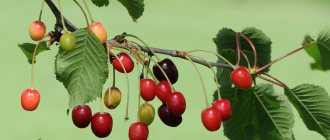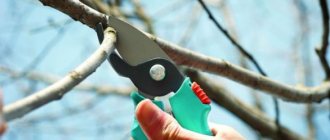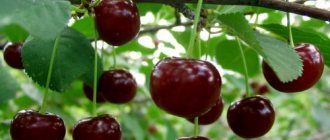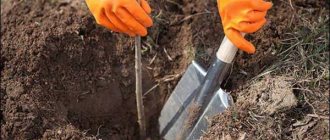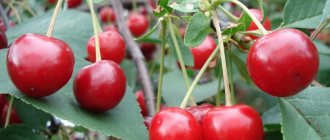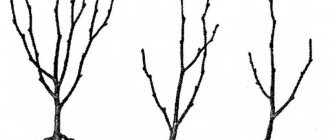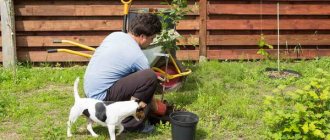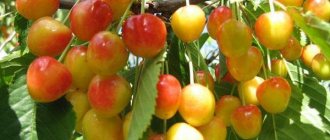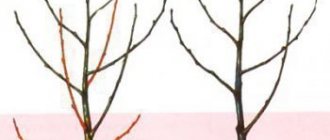Abundant flowering of cherries and sweet cherries cannot yet guarantee a high yield of tasty berries. For fruiting to take place, plants are needed for cross-pollination, wind and insects. The ovaries appear as a result of fertilization of the ovule with a grain of pollen caught on the stigma of a flower. The pollen will germinate in the pistil style and then penetrate the ovary and fertilize the ovule. Pollination is the process of transferring pollen from the pistil to the stigma. When cherry blossoms are early and the number of bees and other insects is limited, gardeners pollinate manually using brushes or cotton swabs.
Amateur gardeners, both beginners and experienced, are often interested in whether cherries can pollinate cherries and vice versa. When purchasing a cherry seedling, you need to decide on the variety, since the plant can be self-sterile. The berry appears only if pollen from another variety of cherry or sweet cherry gets on the pistil of the flower. Therefore, for cherries they select a “company” of pollinating varieties and, of course, they need bees. But cherries are of different varieties and bloom at different times. Therefore, pollinators need to be selected according to the flowering time of a self-sterile cherry variety, which in rare cases will help to obtain a harvest. It’s even better to plant self-fertile varieties, that is, self-pollinating, capable of being pollinated by their own pollen on their own in any weather. As for cherries, if there are pollinating cherries in the neighborhood or other cherries, you can get a high yield due to cross-pollination.
Pollination rules
Pollination of cherries directly affects the volume of the harvest. In order for the flower to be fertilized and the ovary to form in its place, pollen must fall on the pistil. All these processes are influenced by different factors, so the result is not always positive.
Related article:
How to plant cherries correctly
The essence of the process
Flowers are pollinated by wind or insects that carry pollen. If the flowering period begins earlier than expected, then there may still be no pollen or it may be present in insufficient quantities. In addition, the process of its transfer may be disrupted due to unsuitable weather conditions.
In addition, not all varieties are able to pollinate on their own. Therefore, it is necessary to have several trees growing nearby, including those that can self-pollinate with their pollen. In this case, the process occurs inside one flower (the pollen from its anther is transferred to the pistil) and can even occur in the bud.
Cross pollination occurs between flowers of different cherry trees. From a biological point of view, it is more valuable, since it transfers different varietal characteristics to the fruit. But at the same time, the result of such a process is too dependent on weather conditions and may be disrupted if they do not meet certain requirements.
Related article:
Sweet cherries for the Moscow region
Influence of weather conditions
The weather during the flowering period has a significant impact on the fertilization of the ovary. Insects actively pollinate cherry flowers on quiet, dry and moderately warm days, and during rain, cold weather or strong winds they stop their work.
In addition, deteriorating weather conditions also affect the flower itself:
- in extreme heat, the pestle becomes less sensitive;
- in case of frost, the parts involved in the fertilization of the ovule are damaged;
- when it rains, water washes away the pollen that falls on the pistil;
- High humidity creates conditions for the activation of fungal infections, which negatively affect the development of fruits.
With any of the above weather deteriorations, much fewer flowers are pollinated and, accordingly, fewer ovaries are formed.
Related article:
How to prune cherries
Artificial pollination
If during flowering there is a prolonged deterioration in weather conditions or only self-sterile trees are planted on the site and there are no suitable pollinators, then in order to obtain a harvest you need to help them pollinate. Before pollinating cherries artificially, you need to familiarize yourself with some rules:
- pollen collection and transfer is carried out only on dry, warm, windless days;
- it is shaken out into pre-prepared bags, which are then tightly closed, preventing the collected material from spilling out and foreign particles from getting into it;
- then use a small soft brush or cotton swab to capture a small amount of pollen and apply it to the flowers being pollinated;
- in one approach, only part of the flowers are processed, choosing the recently opened ones (the highest quality berries are formed from them);
- If there are a lot of ovaries, they are thinned out, reducing the fruit load.
Related article:
How to prune cherries
The advantage of artificial insemination is the guaranteed result and the absence of problems characteristic of natural pollination. At the same time, the event requires a lot of labor and time.
Interesting! How to plant cherries correctly
Diseases that cause leaves to fall
How to trim cherries
There are a number of diseases that cause leaves to turn yellow and fall off:
- Verticillium - in the spring, cherries begin to dry out. It all starts with small branches, then large ones are affected, and after a couple of years the tree dies. The main sign of the disease is considered to be rust-colored gum flowing from cracks and peeling strips of bark. Traces can also be seen on fallen leaves. For treatment, you need to remove the gum, clean it and treat it with varnish. Then treat the plant with special substances. To avoid the disease, you need to choose soil without groundwater, do not plant strawberries or melons nearby, and spray with Bordeaux mixture;
- Moniliosis is a common disease of stone fruit crops. With it, flowers fall off, shoots and branches dry out. For treatment, diseased branches are cut off, after which they are burned, the crown is thinned out a little for ventilation, the cracks are covered with varnish, and the plant is treated with copper sulfate;
- The California scale insect is an insect that measures 2mm. It feeds on tree sap, which causes the bark to peel or crack. Affected branches must be cut and burned, after which the tree must be treated with pesticides;
- Bark beetles - depending on the type of insect, different trees are affected. The gypsy bark beetle attacks a healthy tree, and the sapwood settles on weakened or old plants. A sign of cherry damage is burrows in the branches. To prevent the appearance of insects, it is necessary to carry out constant feeding, watering, spraying, and treatment with special substances against bark beetles. We need to cut off the branches and burn them.
When it is unknown why the leaves turn yellow and fall off, it is necessary to study the roots of the tree. The reason may be the May mite, which feeds on roots, moles or anthills close to the root system. They greatly harm the supply of nutrients to the tree, which will inevitably lead to the leaves turning yellow and falling off.
Thanks to a good harvest, you can prepare compotes, preserves, jams and much more. But for this you need to get tasty, whole berries without worms or signs of disease.
It is very important to follow all the rules for planting and caring for a cherry tree. Then you will forget about wilting, yellowing and falling leaves, the occurrence of fungal and other diseases, insects
Your tree will bear tasty, large and aromatic fruits every year.
Types of cherries by pollination method
Most varieties of cherry trees need pollinating neighbors from which insects will take pollen to carry. To avoid having to make additional efforts when growing a cherry orchard, it is important to choose the right seedlings for it.
Cherries, like many other stone fruits, are divided into 3 types based on their ability to pollinate:
- self-fertile - pollinate independently (with their own pollen inside one flower);
- partially self-fertile - no more than 10% of flowers can be pollinated independently (the remaining 90% will be fertilized if there is a suitable pollinator neighbor);
- self-sterile - a maximum of 3% of flowers are self-pollinating, that is, without a representative of another variety (or cherry) growing nearby, there will be practically no fruit.
Related article:
Sweet cherries for the Moscow region
Despite the indicated abilities of self-fertile trees, in the presence of a pollinator, their yield also increases significantly, and the quality of the berries improves. Therefore, it is extremely important to plant a neighbor next to any cherry tree that will pollinate it. But self-sterile and partially self-fertile cherries especially need this.
How else can you increase productivity?
If all the conditions are met, and the Miracle Cherry does not produce the desired yields, pay attention to the following points in care:
- Freezing of the kidneys. Of course, winter frosts, and even in the absence of snow, are dangerous for cherry buds. But autumn and spring frosts affect them much more seriously. To avoid this, before flowering begins, you can spray the cherries with preparations that increase the tree’s resistance to adverse weather conditions (“Novosila”, “Epina-extra”). If frosts are expected during flowering, before them it is necessary to water the tree generously and, if possible, cover it with covering material. In late autumn, in order to avoid freezing, it is better not to water the crops or feed them with nitrogen fertilizers.
- Correct watering three times. During shoot growth, a couple of weeks before the berries ripen and immediately after harvesting the fruits (3-6 buckets/tree).
- Feeding. Important! They begin to feed cherries only in the third or fourth year of life.
If you want to collect large harvests of the Miracle Cherry, use pollinators - plant cherries next to it or spray it with special preparations. But do not forget that pollinators are not a panacea; the tree requires comprehensive care.
Sources:
https://0sade.ru/vishnja/mozhet-li-vishnja-byt-opylitelem-chereshni.html https://ovosheved.ru/chereshnya/opylenie.html https://sait-pro-dachu.ru/vishnya- i-chereshnya-mogut-li-oni-opylyat-drug-druga/ https://sadim.guru/kakie-sorta-opylitelej-podobrat-dlja-vishni-i-chereshni/ https://abekker.ru/articles/ opyliteli-dlya-chudo-vishni
Pollinator requirements
Regardless of whether the cherry tree is pollinated by cherries or cherries of another variety, the chosen pollinator must match it in three ways:
- flowering period;
- fruiting period;
- life expectancy.
To minimize the likelihood of error, when forming a garden, you should choose diverse varieties, planting cherry and cherry trees in groups of 3-4 seedlings. This will ensure high yields of tasty berries from varieties with different abilities for pollination and self-pollination.
Related article:
How to prune cherries
Compatibility options for cherry varieties
Breeders draw the attention of gardeners to the fact that not all varieties planted nearby are compatible for pollination. This happens even when the distance between the trees is very small.
At the stage of planting a garden, you need to immediately select not one, but at least three varieties that are close to each other in terms of flowering time, ripening and durability of the tree in principle.
Cherry-cherry hybrid
Both sweet cherries and sour cherries are close relatives. Many gardeners are concerned about whether they can be each other's pollinators.
In fact, hybrids of cherries and sweet cherries were bred a long time ago. They are called DYUK. But only recently have gardeners had to deal with them. It’s just that many gardeners bought seedlings under the guise of “cherry”, which was previously presented by sellers as a new variety of large-fruited sweet cherry.
Advice. DYUKs practically do not get sick, since they received the large-fruited cherries and winter hardiness from the cherries.
The most important thing when planting these hybrids is not to forget that they are completely self-sterile and do not pollinate each other at all, that is, hybrids do not pollinate their own kind. The best pollinator for them will be cherries.
For beginning gardeners, it is important to know whether cherries can pollinate cherries. Most cherry trees cannot be pollinators for cherries. The Lyubskaya cherry can be an ideal pollinator. but other cherry pollinators may be suitable.
Compatibility of cherry varieties
Iput is considered the best pollinator among cherry trees; ideally, it is recommended to plant it with its own pollinator - the Revna cherry variety. This is the only way to guarantee a high harvest of cherries, sweet cherries, and DYUKs.
A good example of a rich harvest is the hybrid Griot Ostheim, which is pollinated by cherries. Its harvest is about 1 quintal from an eight-year-old tree. But the same tree, but pollinated by cherries, produces a yield of only 0.5 centners. And if you completely leave the tree without a pollinator, the yield will be only about 5 kg.
With properly organized pollination of cherries, gardeners can safely be proud of a tasty and rich harvest!
Proper care
The tree trunk will require care throughout the life of the plant. It should be moist, loosened, free of weeds and mulched. It is good to plant marigolds around the circumference. These flowers attract ladybugs - natural enemies of aphids, which like to land on young cherry shoots.
Immediately after planting, the cherries must begin to be shaped. The first step is to inspect the crown.
If there is no obvious “leader” among the shoots, it needs to be “nominated”: choose a good top one, pull it to the support, giving it a vertical position, and tie it up. The remaining shoots are future skeletal branches of the cherry tree. They should be shortened at the lower bud to a length of 25 cm.
In the first year after planting, young cherries only need to be watered. In the fall, to better prepare the plant for wintering, you can feed it with superphosphate (2 tablespoons per 1 sq. m of crown projection). The Iput variety tolerates frost well, but at a young age it is better to provide it with additional protection.
Non-woven covering materials perform well in this capacity. Before the onset of frost, a frame is installed around the seedling and covered in several layers with agrospan or spunbond with a thickness of 60 g/sq. m.
It is better not to use the popular burlap to cover cherries. This material strongly absorbs moisture and is not able to protect the shoots from freezing.
In the second year, cherries will need spring nitrogen fertilizing. It is better to use good manure humus, then there is no risk of “overfeeding” the plant.
It is also necessary to continue the formation of the crown.
There are different opinions about pruning cherries. For example, the famous pomologist Lev Platonovich Simirenko believed that pruning is contraindicated for this crop. Cherry has a low shoot-forming ability, and its crown itself is formed sparsely. Even in mature trees, you can often get by with sanitary pruning and simple tapping of shoots directed into the crown.
However, to stimulate fruiting and better yield, it is necessary to accustom the skeletal branches of the cherry tree to the correct position from a young age. The following rule applies here: the greater the angle between the shoot and the trunk, the better the harvest. To ensure this condition, in the old days bast shoes were hung on the branches of young seedlings. Now you can use the method of bending the shoots:
- In spring, a loose loop of twine is attached to a side branch, closer to the top.
- The second end of the twine is tied to a peg in the ground so that the branch forms a right or even an obtuse angle with the trunk.
- The plant spends the entire summer in this “crucified” position. In the fall, the loop can be trimmed.
In mid-summer, the cherry tree is inspected for this year’s growth. Cherries are capable of driving out them up to 60 cm or more in length per season. This is not very good - long growths do not have time to ripen before winter. Therefore, they should be pinched. Among other things, this procedure stimulates the branching of cherries.
To keep the tree compact, you need to monitor the height of the central conductor. A leader height of three meters will be sufficient.
When it grows to this mark, it is cut off and transferred to the nearest skeletal branch.
Please tell me, pollinators for Valery Chkalov’s cherries and for honeycomb cherries Miracle Cherry
Elena the Wise
About 80% of all plant species have a biotic type of pollination, 19.6% are pollinated by wind. With cross-pollination, plants can produce two main types of plants: monoecious and dioecious.
Nataly Sitko
At the same time, the stamens are male organs, and the pistil (ovule) is female - from it, if fertilization is successful, a seed can appear. I don’t know, cherries don’t grow here. (but, as I think, everyone, both taste and size of the tree, we have bushes)
1. Is it suitable for Siberia? — they recommend that fruit buds last up to -35. 2. Do you need a different variety of pollinator? — Self-fertility is low, but it is enough to plant a few bushes. 3. When does it begin to bear fruit? - in 5-6 years the harvest is 2-3 kg of berries. 4. Does it produce shoots? The main advantage of felt cherry is that there is no growth.
Filipich
6.Different in the taste of berries. The fruits are watery, somewhat fresh, and sweetish (not for everyone). The branches are simply strewn with berries.
Elena Akentyeva
It’s possible, they are all bee-pollinated and no one grows these trees from seeds.
